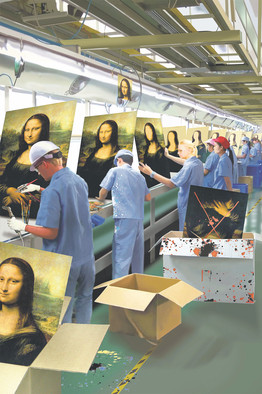Week 3 - Robotics + Art
This week's topic has to be one of my favorites thus far. Robots, who knew how involved they would be in our day-to-day life. In the introductory lectures by Dr. Vesna, she discussed how machinery and machinery work was one of the initial forms of robotics and as time progressed we moved from theoretical robots to AI. It interests me significantly how the Industrial Revolution has built up to us now having AI and other different robots that feel so "real".
On the topic of the industrial revolution and low wages, we can begin to talk about where the word robot originated from. According to the lecture, material robot originates from the word robota, which means to work and this can remind us of the unfair free labor that was happening before machines were used when they were used the users had to be people working low-wage jobs to feed their families and make ends meet. This later became more focused on robots doing this job and more active robotic machinery being used meaning people would lose their jobs. (lecture part 2).
When speaking about robots we often oversee the way that culture informs our perspective on them. When speaking about Art and Science Benjamin has a very discerned perspective he talked about how because of mechanical reproduction paintings like those done by Picasso lose their 'touch' because they are so easily recreated. He talked about how this mass production of art created a culture of reactionary response rather than a more genuine and real response since everything was already viewable at their fingertips. I agree with his narrative and find it kind of sad that this is our reality but it is also fascinating because of our intelligence we have been able to make things more edible.
Lastly, the thing that we initially think about when we think of robots is AI which was initiated first by computers being created which Dr. Vesna talked about in her lecture. Due to the production of computers, people were able to create AI software which essentially has taken over the internet by a sweep. Their software has been conjoined with other features that allow robots to have such real interaction/movements which is very progressive. In the TED talk video where the robot was able to move like a human although it would blow away so easily, it was very cool how it didn't fall over and that's due to AI/computer programing which is insane.
References
Benjamin, Walter. The Work of Art in the Age of Mechanical Reproduction. 1936.
Vesna, Victoria. “ROBOTICS part 1” Bruinlearn, https://bruinlearn.ucla.edu/courses/183769/pages/unit-3-view?module_item_id=6671238
Vesna, Victoria. “ROBOTICS part 2” Bruinlearn, https://bruinlearn.ucla.edu/courses/183769/pages/unit-3-view?module_item_id=6671238
Vesna, Victoria. “ROBOTICS part 3” Bruinlearn, https://bruinlearn.ucla.edu/courses/183769/pages/unit-3-view?module_item_id=6671238
Hong,Denis. https://www.ted.com/talks/dennis_hong_7_new_species_of_robot_that_jump_dance_and_walk_on_water. 2021
Images
https://www.ted.com/talks/dennis_hong_7_new_species_of_robot_that_jump_dance_and_walk_on_water.
https://preview.redd.it/hfurt3diyrn31.jpg?auto=webp&s=00288ee6d1c3d629e13fde4184117f679957640d
https://scalar.chapman.edu/scalar/ah-331-history-of-photography-spring-2021 compendium/media/mona%20lisa.jpeg


Comments
Post a Comment